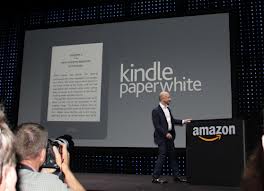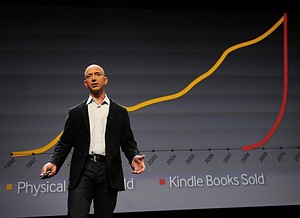Amazon CEO Jeff Bezos used PowerPoint in his recent Kindle Fire presentation, but he did so differently than many companies have done in the past. Instead of bulletpoints, he used slides that were light on text and heavy on images.

“The typical PowerPoint slide has forty words,” writes Carmine Gallo. “It was nearly impossible to find forty words on ten slides of the Amazon presentation. Bezos told the story behind the new products in images and text. I’ve discussed this technique before in more detail but in short, it’s called Picture Superiority. It simply means that the brain processes information more effectively when the information is presented in pictures and words instead of words alone. Neuroscientists have also found that when a slide (or advertisement) contains pictures and words, it’s best to have the picture on the left side of the page or slide and words on the right. This is exactly what Bezos did for a majority of his slides.”
Bezos introduced the new Kindle Fire HD with slides that just had images and very elemental words, like movies, games, photos. The final slide simply had ‘Kindle Fire HD, 7″ 16GB, $199.’
The presentation also included the Kindle Paperwhite. Notably, instead of just saying that it has eight weeks of battery life, it showed a picture of a calendar with the months September and October starting with the day of the presentation, connecting watchers to the presentation.

“I know what some of you are thinking — it works for Bezos because he’s revealing products that people can see and touch,” noted Gallo. “Let me be clear — picture superiority works in any presentation, even for the most complex ideas. I recently gave a presentation on the topic of communication and storytelling to scientists at one of America’s largest nuclear labs. One person implemented the techniques immediately and sent me an email, saying it helped him deliver one of the most persuasive presentations of his career.”
“In no way am I advocating that you ditch PowerPoint. I am recommending that you ditch PowerPoint as we know it — dull, wordy, and overloaded with bullet points. Image-rich presentations work effectively because pictures appeal to the right hemisphere of the brain — the emotional side. You can have great ideas backed up by data and logic, but if you don’t connect with people emotionally, it doesn’t matter,” concluded Gallo.
Source: Forbes.com

